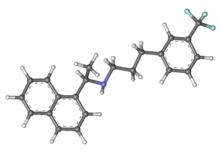Cinacalcet
Cinacalcet, sold under the brand name Sensipar and Mimpara, is a medication used to treat hyperparathyroidism due to kidney failure.[4] and high blood calcium due to parathyroid carcinoma.[5]
 | |
 | |
| Clinical data | |
|---|---|
| Trade names | Sensipar, Mimpara |
| AHFS/Drugs.com | Monograph |
| MedlinePlus | a605004 |
| License data |
|
| Pregnancy category | |
| Routes of administration | By mouth |
| ATC code | |
| Legal status | |
| Legal status | |
| Pharmacokinetic data | |
| Bioavailability | 20 to 25% increases if taken with food |
| Protein binding | 93 to 97% |
| Metabolism | Hepatic (CYP3A4-, CYP2D6- and CYP1A2-mediated) |
| Elimination half-life | 30 to 40 hours |
| Excretion | Renal (80%) and fecal (15%) |
| Identifiers | |
IUPAC name
| |
| CAS Number | |
| PubChem CID | |
| PubChem SID | |
| IUPHAR/BPS | |
| DrugBank | |
| ChemSpider | |
| UNII | |
| KEGG | |
| ChEBI | |
| ChEMBL | |
| CompTox Dashboard (EPA) | |
| ECHA InfoCard | 100.208.116 |
| Chemical and physical data | |
| Formula | C22H22F3N |
| Molar mass | 357.412 g/mol g·mol−1 |
| 3D model (JSmol) | |
SMILES
| |
InChI
| |
| | |
Cinacalcet acts as a calcimimetic (i.e., it mimics the action of calcium on tissues) by allosteric activation of the calcium-sensing receptor that is expressed in various human organ tissues.
Cinacalcet was approved in the United States in March 2004,[6][7][8] and was the first allosteric G protein-coupled receptor modulator to enter the pharmaceutical market.[9] In 2014, cinacalcet was 76th out of the top 100 drugs in the list of largest selling pharmaceutical products.[10]
Medical uses
Cinacalcet is indicated for the treatment of tertiary hyperparathyroidism in people with chronic kidney disease on dialysis and hypercalcemia in people with parathyroid carcinoma.[11] Cinacalcet can also be used to treat severe hypercalcemia in patients with primary hyperparathyroidism who are unable to undergo parathyroidectomy.[12]
In the treatment of tertiary hyperparathyroidism due to chronic kidney disease on dialysis it does not appear to affect mortality.[13] It does decrease the need for a parathyroidectomy but can cause more issues with low blood calcium levels.[13]
Pregnancy and lactation
Cinacalcet has pregnancy category C in the US, meaning that adequate and well-controlled studies involving cinacalcet in pregnant women have not been done.[6][1]
Studies have not been done in lactating women; therefore it is not known whether cinacalcet is excreted into human milk.[6][1]
Contraindications
Hypocalcemia (decreased calcium levels) is a contraindication of cinacalcet. Patients who have serum calcium levels less than 7.5 mg/dL should not be started on cinacalcet. Hypocalcemia symptoms include parathesias, myalgias, muscle cramping, tetany, and convulsions. Cinacalcet should not be administered until serum calcium levels are above 8.0 mg/dL and/or hypocalcemia symptoms are resolved.[6]
Adverse effects
Common side effects of cinacalcet include stomach upset, vomiting, diarrhea, dizziness, nausea, weakness, and chest pain.[12]
Clinical trials conducted in the United States by Amgen to determine whether the drug is safe in children were halted by the U.S. Food and Drug Administration (FDA) in February 2013, following the death of a 14-year-old patient.[14]
Overdose
Serious side effects, including overdose symptoms, of cinacalcet include:[12]
- burning
- tingling
- unusual feelings of the lips, tongue, fingers, or feet
- muscle aches or cramps
- sudden tightening of muscles in hands, feet, face, or throat
- seizures
Interactions
Cinacalcet is a strong inhibitor of the liver enzyme CYP2D6 and is partially metabolized by CYP3A4 and CYP1A2. Dose adjustments may be necessary if patients are treated with CYP3A4 and CYP1A2 inhibitors and medications that are metabolized by CYP2D6.[6]
Pharmacology
Mechanism of action
Cinacalcet is a drug that acts as a calcimimetic (i.e. it mimics the action of calcium on tissues) by allosteric activation of the calcium-sensing receptor that is expressed in various human organ tissues. The calcium-sensing receptors on the surface of the chief cell of the parathyroid gland is the principal negative regulator of parathyroid hormone secretion.[15] Cinacalcet increases the sensitivity of calcium receptors on parathyroid cells to reduce parathyroid hormone (PTH) levels and thus decrease serum calcium levels.[11]
The intravenously administered drug etelcalcetide has the same mechanism of action.[16]
References
- Use During Pregnancy and Breastfeeding
- "Sensipar Tablets". NPS MedicineWise. 1 May 2018. Archived from the original on 7 December 2019. Retrieved 7 December 2019.
- "Mimpara 30 mg Film-coated Tablets - Summary of Product Characteristics (SmPC)". electronic medicines compendium (emc). 8 July 2019. Archived from the original on 7 December 2019. Retrieved 7 December 2019.
- Torres PU (2006). "Cinacalcet HCl: a novel treatment for tertiary hyperparathyroidism caused by chronic kidney disease". Journal of Renal Nutrition. 16 (3): 253–8. doi:10.1053/j.jrn.2006.04.010. PMID 16825031.
- "Sensipar for Parathyroid Carcinoma". Amgen. 2009. Retrieved 25 September 2009.
- "Highlights of prescribing information" (PDF). Amgen. Retrieved 29 October 2014.
- "Drug Approval Package: Sensipar (Cinacalcet HCI) NDA #021688". U.S. Food and Drug Administration (FDA). 7 December 2019. Archived from the original on 7 December 2019. Retrieved 7 December 2019.

- "Sensipar". U.S. Food and Drug Administration (FDA). Archived from the original on 7 December 2019. Retrieved 7 December 2019.

- Bräuner-Osborne H, Wellendorph P, Jensen AA (2007). "Structure, pharmacology and therapeutic prospects of family C G-protein coupled receptors". Current Drug Targets. 8 (1): 169–84. doi:10.2174/138945007779315614. PMID 17266540.
- Drugs.com U.S. Pharmaceutical Sales - Q4 2013, updated Feb. 2014
- 2014 Nurses Drug Handbook (13th ed.). Burlington, MA: Jones & Bartlett Learning. 2014. pp. 245–6. ISBN 978-1-284-03115-7.
- "Cinacalcet". U.S. National Library of Medicine. Retrieved 29 October 2014.
- Ballinger, AE; Palmer, SC; Nistor, I; Craig, JC; Strippoli, GF (9 December 2014). "Calcimimetics for tertiary hyperparathyroidism in chronic kidney disease patients". The Cochrane Database of Systematic Reviews. 12 (12): CD006254. doi:10.1002/14651858.CD006254.pub2. PMID 25490118.
- Edney, Anna (February 26, 2013). "Amgen Pediatric Trials of Sensipar Halted by FDA After Death". Bloomberg Businessweek. Archived from the original on March 2, 2013. Retrieved February 26, 2013.
- "Cinacalcet".
- "Amgen Submits New Drug Application For Novel Intravenous Calcimimetic Etelcalcetide (AMG 416)"
External links
- "Cinacalcet". Drug Information Portal. U.S. National Library of Medicine.